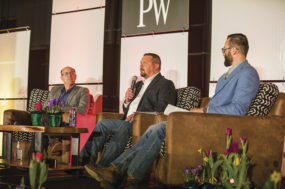Eight years ago, I stood in line in front of the Vatican. I had a friend living in Italy at the time, and we took the train into Rome. Although we had gotten there early, there were – unsurprisingly – a lot of people ahead of us.
The wait was augmented by a group of 20 Japanese tourists who had started in the back but, one by one, ended up in front of us. I would have said something but I’m too shy, and frankly, it was somewhat impressive.
After St. Peter’s Basilica and the Apostolic Palace, we made it to the long-awaited highlight: the Sistine Chapel. The room was crowded, and although there were signs telling us to be quiet, the low rumble of excited foreigners filled the space.
The reverence was further punctured by two tall Italian men with slicked-back hair and black suits that intermittently clapped their hands and shouted in a deep voice, “No photo.” It intimidated me enough that I didn’t take a picture, but it did little to stop the Japanese tourists.
“Isn’t this something?” my friend whispered to me. It certainly was. The Sistine Chapel is one of the biggest cultural icons in history, and everyone grows up hearing about it. “The Last Judgment,” God and Adam touching fingertips in “The Creation of Adam” – I never thought I would get to see it in person.
It was a great moment. Still, another uncomfortable thought crept in: Would I have known this was a great accomplishment if someone hadn’t told me? Could I tell its artistic value from any other painting?
Here’s what I never told anyone: I don’t know why the Sistine Chapel is special.
Like everyone else in 4-H, I started dairy judging when I was 8. In winter and spring, we had “cow college” every Saturday at a local farm where we practiced before the summer tours started. Judging came hard to me. I had a better mind for Dairy Bowl and the memorization of facts, and did all right in showmanship, which I saw as a performance.
Judging cattle, however, is largely conceptual – one has to weigh the different traits of a cow and put it into a bigger picture. It is, simply, a way of seeing things. You have to “get it.” Unfortunately, I didn’t get it for a long time, and I was always in last place.
I remember the farm, the weather and the brownies they served the day I finally wasn’t at the bottom in cow college. I placed in the middle of my age group, and it was a big moment.
I saved the pen, because I figured there must have been magic in it. Although this probably didn’t happen, I imagine the person announcing the scores taking a second look before saying my name. Maybe she even gave an approving nod. Although this definitely didn’t happen, it should have: They carried me out of the barn on their shoulders, chanting my name. Finally, I had arrived. I had gotten it.
I continued at it and in later years won a few small tours and competed at both national contests. I was never great at it, but I enjoyed it. I found that I particularly liked oral reasons. There was something about standing in front of someone official knowing that you placed the class backwards and having to formally explain yourself that ended up being useful later in life.
Looking back, dairy judging challenged a part of me that didn’t come naturally. As a result, I gained a new way of seeing things, as well as a way to talk about them.
Several months ago, I stayed with an artist in a small village in Iceland. After dinner, she showed me her work. “What do you think?” she asked. They looked like children’s drawings, but with people who had very pronounced genitalia. “Interesting,” I said, continuing to nod into the awkward silence.
Art frustrates me. Simply, I don’t have an eye for it. I don’t get the rules, and I can’t tell when other people are appreciating it because there’s value in it or because someone told them it was art. I try to approach it humbly but am afraid to get bamboozled. I find myself wondering: What is so special about the Sistine Chapel?
Using past experience to navigate present challenges is probably only human. Using cattle judging to figure out Andy Warhol is probably a little hillbilly. Still, in a museum, I move around a painting the same way I would a class of Brown Swiss, looking at each piece up close first and then backing up for another perspective like they taught us in cow college.
I hear people around me talking about the composition as if they got it, and because I can place cows, it makes me think that someday I will get it too. Maybe art and agriculture are an odd couple, but I find myself using the latter to negotiate the other things I don’t understand.
This is my trick: If I can put it into the context of farming, suddenly it is on my terms and not so intimidating. And who knows where the potential ends? I’m secretly hoping that someday feeding calves will make me a better dancer and bedding stalls will improve my fashion sense. PD
Ryan Dennis is the son of a dairy farmer from western New York and a literary writer. The Dennis family dairies and maintains a 100-plus cow herd of Holsteins and Shorthorns.

-
Ryan Dennis
- Columnist
- Email Dennis




